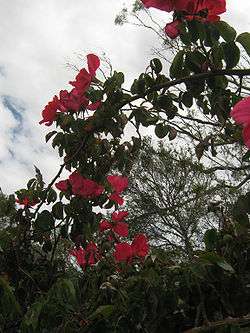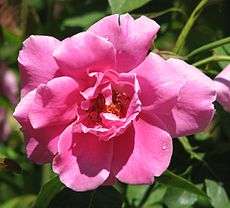Alister Clark
Alister Clark (1864–1949) was the best known and most influential Australian rose breeder. His roses were the most widely planted in Australia between the World Wars and made an enduring difference to the appearance of Australian cities. His experiments hybridizing Rosa gigantea were in world class and have never been surpassed.[1]




Biography
Alister Clark was the son of an immigrant Scottish tenant farmer who did well in Australia, leaving his family with several outback cattle stations and “Glenara,” a big property in a valley north of Melbourne.[2] His gently brought up children knew Europe well: Alister was educated in Scotland and at Cambridge.[3] He married a New Zealander with a fortune and never worked, giving himself over to the business of being a gentleman: huntsman, polo player, racehorse owner, golfer, photographer — and rose breeder.[4] He began his rose breeding by ordering roses from Paul & Son in England; later they came from the Nabonnand nursery at Golfe-Juan on the Riviera.[5] He released about 150 roses between 1912 and his death, usually through the garden and sporting clubs he gave the royalties to.[6]
Daffodils
Clark was also a keen breeder of daffodils. In 1897 Clark had joined a syndicate, including Thomas Hanbury (creator of the famous Riviera garden of La Mortola) and Ellen Willmott (of Warley Place), which bought the stock of daffodil bulbs bred by Rev. G. H. Engleheart.[7] He also bought half the stock of a bulb collection made by English Shakespearean actor, George Titheradge. According to Tommy Garnett, the best known of Clark’s daffodils is probably ‘Mabel Taylor’, still in commerce and used for breeding.[7]
Roses
Clark's main aim as a breeder was to produce roses that were hardy in the hot dry climate of southern Australia. To this end he made original use of crosses to Rosa gigantea, which produced in the second generation some of the toughest and most freely blooming roses ever bred: 'Lorraine Lee'[8] of 1924 and 'Nancy Hayward'[9] of 1937 have never lost public favour.[1] 'Black Boy'[10] of 1919, 'Lady Huntingfield'[11] of 1937 (named after the State Governor's wife) and 'Squatter's Dream'[12] of 1923 (named after a racehorse) are roses which have been unknown or underrated outside Australia.[13][14]
Soon after the First World War Clark's experiments with Rosa gigantea slowed down. He turned to creating what are essentially hybrid teas in a wide variety of forms: low shrubs ('Mab Grimwade'),[15] high bushes ('Editor Stewart'),[16] rampant climbers ('Mrs Richard Turnbull'),[17] pillar roses ('Princeps'),[18] roses for hedges ('Sunny South'),[19] ramblers ('Gladsome')[20] and dwarves ('Borderer').[21][22] He seems to have had no breeding plan beyond making as many crosses as possible at “Glenara” and seeing what came up. His grounds became “a vast nursery for the propagation of roses and daffodils.”[23] Roses should be tested in the climate they were meant for, he said. And he insisted that a seedling (like a yearling) takes three years to show what it can do.[24]
Perhaps it is surprising for a man who wore a bowler hat and wing collar to the races in 1920, but his roses have the bright pinks, creamy apricots and hard reds of between-the-wars taste.[25] It was the great age of the single or near-single rose; he bred 'Nancy Hayward,' 'Cicely Lascelles'[26] and 'Squatter's Dream.' It is difficult to tell how his taste adjusted to the 1940s since 30 of the 40 roses he produced then have been lost, casualties of war.[6] In any case, his roses of all periods have an irregularity which rose fanciers find endearing.[13]
Twenty years after his death in 1949 Alister Clark remained the most important Australian rose breeder. A.S. Thomas was the Australian registrar of roses and president of the National Rose Society of Victoria. The 1967 edition of his Better Roses prints a list of eighty "highly prized cultivars" from Australia and New Zealand. Twenty of them are roses by Alister Clark. Seven are by Frank Riethmuller. No other breeder rates more than two.[27]
'Lorraine Lee,' 'Nancy Hayward' and 'Black Boy' have never left the nursery catalogues.[22] Other Clark roses went out of fashion after his death. Still others were lost or never released.[6] But many have been revived since the 1990s by such enthusiasts as the writer Susan Irvine and the nurseryman John Nieuwesteeg.[28] A heading in Charles Quest-Ritson's authoritative Climbing Roses of the World says simply "Alister Clark: The Great Australian Rose Breeder."[29]
Rose names and dedications
Most of Clark's roses are named after and for women he knew, more often than not from landed families ('Cicely Lascelles,' 'Kitty Kininmonth').[30] Most women in his own family and all wives of Victorian Governors and Australian Governors-General had roses named for them. Lady Gowrie already had one, so hers had to be called 'Zara Hore-Ruthven.'[31] Very few men received roses, all of them rose people in one way or another. Far more are devoted to racehorses: 'Squatter's Dream,'[12] 'Tonner's Fancy,'[32] 'Flying Colours'[33] and so on. Trailing the field are descriptive titles: 'Sunny South,' 'Borderer' and 'Daydream.'[28][34] 'Scorcher'[35] and 'Billy Boiler'[36] were slang for a hot day.
Where Alister Clark roses can be seen
Alister Clark made an enormous and enduring difference to the appearance of Australia. Thousands of plants of 'Lorraine Lee' in particular, bred ninety years ago, can be seen in every temperate town and city.
- Sixty-seven of his available roses are collected at the Alister Clark Memorial Rose Garden[37] in Bulla, the township next to “Glenara.”[37] This collection should not be confused with that of the same name in the Botanic Gardens in St Kilda, a Melbourne suburb, which has about five Clark varieties, unlabelled.
- The National Rose Collection created by David Ruston at Renmark in South Australia has nearly all known Clark climbers.[38]
- The Morwell Centenary Rose Garden in Gippsland lists 38, including the often-confused 'Black Boy' and 'Countess of Stradbroke.'[39]
- In Canberra the centre of the Rex Hazlewood Rose Garden at Old Parliament House has 26 Alister Clark roses, including such relative rarities as 'Mrs Albert Nash.'[40]
- The Victoria State Rose Garden at Werribee Park has a large collection, especially of his gigantea climbers.
- The Geelong Botanic Gardens have 'Borderer,' 'Lady Huntingfield,' Mrs Maud Alston,' 'Mrs Fred Danks' and 'Squatter's Dream.'
- The Adelaide Botanical Garden, South Australia has some, including 'Amy Johnson.'
- The Kodja Place Roze Maze at Kojonup, Western Australia uses hedges of Australian roses, including 32 by Alister Clark.[41]
Public gardens in suitable climates beyond Australia contain a tiny number of his roses. The Monserrate Palace garden at Sintra outside Lisbon in Portugal has three. Sangerhausen in north Germany has a small selection of Clark roses including two which would otherwise be extinct. Many of his roses were popular in the US between the wars and, after a long lapse, interest has revived.[42] So far this is only partly shown in public collections. The Descanso Gardens, La Canada Flintridge, California have had 55 and are said to be restoring their collection. Roses Unlimited of Laurens, South Carolina has 18 Clark roses on its list. 'Borderer' is said to be the Clark rose most popular with American gardeners.[42] A few European collectors of hybrid gigantea crosses have Clark examples in private gardens.
 'Mrs Fred Danks' 1951. Well scented 9-cm mauve–lilac–violet flowers on a two-metre bush; very recurrent. Geelong Botanic Gardens. |
 'Black Boy ' in early spring. Richly scented, climbing to four metres. Margaret Furness photo. |
 'Lady Huntingfield.' Scented 10-cm flowers, very recurrent on a low bush. Werribee Park photo. |
See also
- List of Alister Clark roses
- Alister Clark Memorial Rose Garden
- Aitken, Richard & Looker, Michael (eds) (2002). The Oxford companion to Australian gardens. South Melbourne, Victoria [u.a.]: Oxford University Press. ISBN 0-1955364-4-4. Entry for Alister Clark.
- Alister Clark Stakes
References
- 1 2 Quest-Ritson, Charles (2003). Climbing roses of the world. Portland, Or.: Timber Press. pp. 38–41. ISBN 0881925632.
- ↑ Serville, Paul de (1991). Pounds and pedigrees : the upper class in Victoria 1850-80 (1. publ. ed.). Oxford u.a.: Oxford Univ. Press Australia. pp. 285–6 & 496. ISBN 0195545176.
- ↑ ""HIS HOURS OF EASE.".". The Argus (Melbourne, Vic. : 1848–1957). Melbourne, Vic.: National Library of Australia. 10 November 1923. p. 10. Retrieved 2 January 2014.
- ↑ Garnett, T.R. (1990). Man of roses : Alister Clark of Glenara and his family. Kenthurst, N.S.W.: Kangaroo Press. ISBN 0-86417-332-6.
- ↑ Gilbert Nabonnand on Help Me Find
- 1 2 3 Cox, Peter (1999). Australian roses : roses and rose breeders of Australia. Hawthorn, Vic.: Bloomings Books. pp. 7–18. ISBN 1-876473-02-9.
- 1 2 Garnett, T. R., ‘Clark, Alister’, in Aitken, Richard & Michael Looker (editors). (2002). The Oxford companion to Australian gardens. South Melbourne, Victoria: Oxford University Press. pp. 142–3. ISBN 0-19-553644-4.
- ↑ 'Lorraine Lee' on the Help Me Find website
- ↑ Help Me Find 'Nancy Hayward'
- ↑ Help Me Find 'Black Boy'
- ↑ Help Me Find 'Lady Huntingfield'
- 1 2 Help Me Find 'Squatter's Dream'
- 1 2 Quest-Ritson, Charles & Brigid (2003). The Royal Horticultural Society encyclopedia of roses. London: Dorling Kindersley. ISBN 978-1-4053-3511-9. especially "Alister Clark" p. 97 and 'Lorraine Lee' p. 237.
- ↑ See also Peter Harkness, "Notable Rose Breeders", entry for Clark, Alister (Australia), p. 677 in Beales, Peter; et al. (1998). Botanica's Roses. Random House. ISBN 0-09-183592-5.
- ↑ Help Me Find 'Mab Grimwade'
- ↑ Help Me Find 'Editor Stewart'
- ↑ Help Me Find 'Mrs Richard Turnbull'
- ↑ Help Me Find 'Princeps'
- ↑ Help Me Find 'Sunny South'
- ↑ Help Me Find 'Gladsome'
- ↑ Help Me Find 'Borderer'
- 1 2 Help Me Find list for Clark, Alister
- ↑ H.E. Rundle on 'Clark, Alister (1864–1949),' Australian Dictionary of Biography online at http://adbonline.anu.edu.au/biogs/A080004b.htm retrieved 28 April 2012
- ↑ Clark, Alister (1928). "Hybridization at 'Glenara'". Australian Rose Annual.
- ↑ Garnett, T.R. (1990). Man of roses : Alister Clark of Glenara and his family. Kenthurst, N.S.W.: Kangaroo Press. p. 85. ISBN 0-86417-332-6.
- ↑ Help Me Find 'Cicely Lascelles'
- ↑ Thomas, A.S. (1969). Better roses (fifth ed.). Sydney: Angus and Robertson. pp. 90–91.
- 1 2 Irvine, Susan (1994). A hillside of roses : with a description and illustrated list of Alister Clark roses. South Yarra, Vic.: Hyland House. pp. 77–79 & 118–23. ISBN 1-875657-37-1.
- ↑ Quest-Ritson, Charles (2003). Climbing roses of the world. Portland, Or.: Timber Press. pp. 38–41. ISBN 0881925632.
- ↑ Govanstone, Tilley & Andrew (2010). The women behind the roses : an introduction to Alister Clark's rose-namesakes 1915-1952 (1st ed.). Kenthurst, N.S.W.: Rosenberg. ISBN 9781877058936.
- ↑ Govanstone, Tilley & Andrew (2010). The women behind the roses : an introduction to Alister Clark's rose-namesakes 1915-1952 (first ed.). Kenthurst, N.S.W.: Rosenberg. ISBN 978-1-877058-93-6.
- ↑ Help Me Find 'Tonner's Fancy'
- ↑ Help Me Find 'Flying Colours'
- ↑ Help Me Find 'Daydream'
- ↑ Help Me Find 'Scorcher'
- ↑ Help Me Find 'Billy Boiler'
- 1 2 "Alister Clark Memorial Rose Garden". Hume City Council. Retrieved 16 November 2013.
- ↑ National Rose Collection of Australia
- ↑ Morwell Centenary Rose Garden
- ↑ The Rex Hazlewood Rose Garden
- ↑ Kodja Place Roze Maze
- 1 2 Waering, Gene (August 2007). "Alister Clark roses in America". Heritage Roses. 31 (6): 3–8.